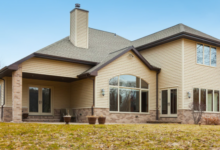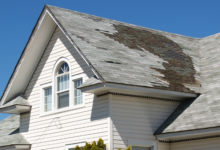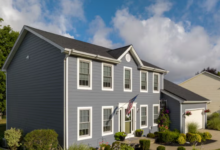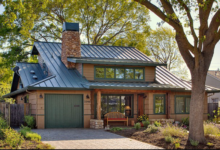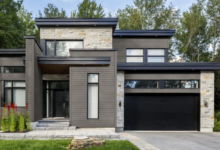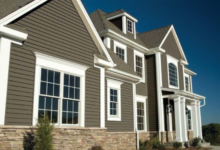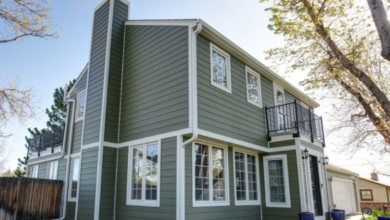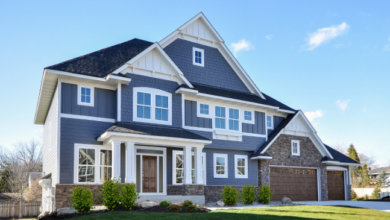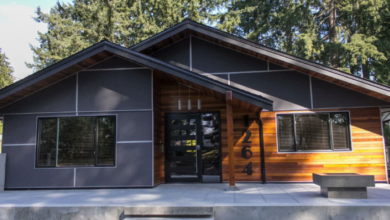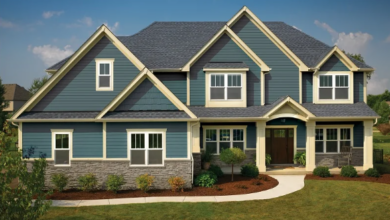Vinyl insulated siding offers a compelling blend of aesthetics, energy efficiency, and durability. This guide delves into the multifaceted world of vinyl insulated siding, exploring its composition, installation, cost-effectiveness, environmental impact, design versatility, and warranty considerations. We’ll uncover the benefits and drawbacks, empowering you to make informed decisions for your home improvement projects.
From understanding the material’s properties and the intricacies of installation to analyzing long-term cost savings and environmental considerations, we aim to provide a comprehensive overview. We will also explore the diverse design options available, helping you visualize how vinyl insulated siding can enhance your home’s curb appeal and overall value.
Vinyl Insulated Siding
Vinyl insulated siding offers a compelling blend of aesthetics, energy efficiency, and durability, making it a popular choice for homeowners. This material represents a significant advancement in exterior cladding, combining the attractive appearance of traditional vinyl siding with the added benefit of built-in insulation. Understanding its composition, manufacturing process, and performance characteristics is key to appreciating its advantages.
Vinyl Insulated Siding Composition and Insulation Types
Vinyl insulated siding is a multi-layered composite material. The outermost layer is a durable vinyl skin, responsible for weather protection and aesthetic appeal. This layer is typically available in a wide range of colors and textures to match various architectural styles. Beneath the vinyl skin lies a core of insulating material, most commonly a rigid foam, such as extruded polystyrene (XPS) or polyisocyanurate (polyiso).
This core provides the thermal insulation properties that contribute to energy savings. The thickness of this foam core directly impacts the R-value, a measure of the material’s resistance to heat flow. Higher R-values indicate better insulation. For instance, a siding panel with a 2-inch thick polyiso core will have a significantly higher R-value than one with a 1-inch XPS core, leading to greater energy efficiency.
The inner layer, often a thinner layer of vinyl, acts as a protective barrier for the foam core.
Durability and Longevity Compared to Other Siding Materials
Vinyl insulated siding boasts considerable durability and longevity. Its resistance to rot, insect infestation, and moisture damage surpasses that of wood siding, eliminating the need for frequent maintenance and repairs common with wood. Compared to aluminum siding, vinyl insulated siding offers better insulation and is less susceptible to dents and scratches, although both materials are relatively low-maintenance. While the lifespan of vinyl siding can vary depending on factors such as exposure to sunlight and weather conditions, it typically lasts for several decades, often exceeding 30 years with proper installation and maintenance.
Wood siding, even with proper treatment, might require more frequent replacement or repairs due to weathering and insect damage. Aluminum siding, while durable, can be susceptible to denting and may not offer the same level of insulation as vinyl insulated siding.
Vinyl Insulated Siding Manufacturing Process
The manufacturing process for vinyl insulated siding involves several key stages. First, the insulating foam core is produced using extrusion or molding techniques, depending on the chosen foam type. The foam is then precisely cut to the desired dimensions and shape. Next, the vinyl layers are formed using extrusion processes. These layers are carefully applied to the foam core, often using a lamination process that ensures a strong bond between the layers.
Finally, the finished panels undergo quality control checks to ensure consistent thickness, color, and overall structural integrity. This manufacturing process relies on precise machinery and quality control to guarantee the durability and performance of the final product. The exact details of the process can vary slightly between manufacturers, but the core principles remain consistent.
Installation and Maintenance of Vinyl Insulated Siding
Installing and maintaining vinyl insulated siding correctly ensures a long-lasting, attractive, and energy-efficient exterior for your home. Proper installation minimizes future problems, while regular maintenance protects your investment and enhances curb appeal. This section details the process of installation and Artikels essential maintenance practices.
Tools Required for Vinyl Insulated Siding Installation
Before beginning installation, gather all necessary tools. Proper tools ensure efficient and safe work. Failing to have the right tools can lead to delays and potentially damage the siding.
| Category | Tool | Description |
|---|---|---|
| Measuring | Tape Measure | Accurate measurements are crucial for precise cutting and installation. |
| Measuring | Level | Ensures the siding is installed straight and level, preventing future problems. |
| Cutting | Circular Saw with Fine-Tooth Blade | Provides clean cuts through the vinyl siding without chipping or cracking. |
| Cutting | Jigsaw | Useful for cutting intricate shapes or around obstacles. |
| Fastening | Hammer | Used to drive nails or staples securely into the siding. |
| Fastening | Nail Gun (Optional) | Speeds up the installation process significantly. |
| Fastening | Siding Nails | Specifically designed for vinyl siding; avoid using common nails. |
| Other | Safety Glasses | Essential for eye protection during cutting and installation. |
| Other | Work Gloves | Protect hands from cuts and splinters. |
| Other | Caulk Gun | For sealing gaps and joints to prevent water damage. |
Step-by-Step Vinyl Insulated Siding Installation Guide
A methodical approach to installation is key to a successful project. Each step builds upon the previous one, ensuring a professional-looking finish.
- Preparation: Begin by carefully measuring the area to be sided. Remove any existing siding and ensure the underlying structure is sound and prepared for installation. This includes addressing any rotted wood or damaged sheathing.
- Starter Strip Installation: Install the starter strip at the bottom of the wall, ensuring it’s level and aligned. This provides a consistent base for the remaining siding panels.
- Panel Installation: Install the first panel, overlapping the starter strip and ensuring proper alignment. Use siding nails or a nail gun to secure the panel, following manufacturer’s recommendations for nail placement.
- Subsequent Panel Installation: Continue installing panels, overlapping each subsequent panel with the previous one. Maintain consistent alignment and spacing throughout the installation.
- J-Channel and Corner Trim Installation: Use J-channel and corner trim to neatly finish the edges and corners of the siding. These pieces provide a clean, professional look and protect the edges from damage.
- Finishing: Caulk all gaps and joints to prevent water infiltration. Inspect the entire installation to ensure proper alignment and secure fastening.
Safety Precautions During Vinyl Insulated Siding Installation
Safety should be a top priority throughout the installation process. Taking necessary precautions prevents accidents and injuries.
- Always wear safety glasses to protect your eyes from flying debris.
- Use work gloves to protect your hands from cuts and splinters.
- Use caution when working at heights; utilize proper scaffolding or ladders.
- Be aware of power lines and other potential hazards.
- Follow all manufacturer’s instructions and safety guidelines.
Vinyl Insulated Siding Maintenance Procedures
Regular maintenance extends the life of your vinyl siding and maintains its appearance. Neglecting maintenance can lead to premature deterioration.
Cleaning vinyl siding is typically straightforward. Use a garden hose with a nozzle to rinse away dirt and debris. For tougher stains, a mild detergent solution can be used. Avoid abrasive cleaners or harsh chemicals, as they can damage the siding’s surface. Regular cleaning, ideally once or twice a year, prevents the buildup of dirt and grime.
Troubleshooting Common Vinyl Insulated Siding Installation Problems
Addressing problems promptly prevents further complications. Early detection and correction are essential for a successful installation.
Gaps between panels are often caused by improper installation or expansion and contraction of the material due to temperature changes. Misalignment can result from inaccurate measurements or uneven surfaces. To address gaps, carefully remove the affected panels and reinstall them, ensuring proper overlap and alignment. For misalignment, check the underlying structure for levelness and adjust accordingly before reinstalling panels.
In some cases, additional caulking may be needed to seal minor gaps.
Vinyl Insulated Siding Installation and Maintenance Checklist
A checklist helps ensure all steps are completed and that regular maintenance is performed. This systematic approach prevents overlooking crucial details.
| Task | Completed |
|---|---|
| Proper measurements taken | ☐ |
| All necessary tools gathered | ☐ |
| Starter strip installed correctly | ☐ |
| Panels installed with proper overlap and alignment | ☐ |
| J-channel and corner trim installed neatly | ☐ |
| All gaps and joints caulked | ☐ |
| Regular cleaning performed (at least annually) | ☐ |
| Inspection for damage or loose panels | ☐ |
Cost and Value of Vinyl Insulated Siding
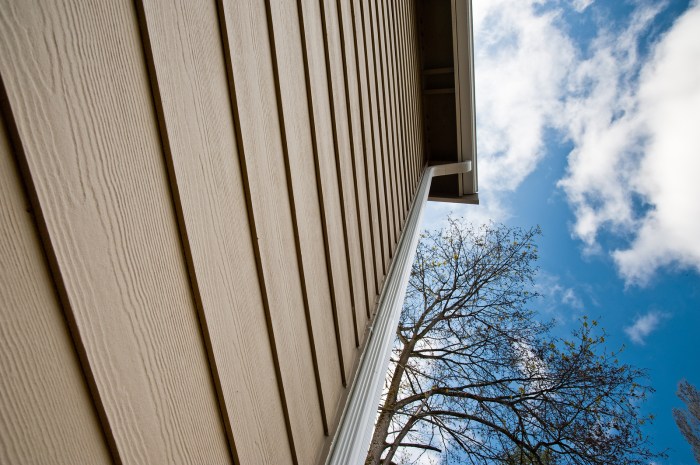
Choosing new siding is a significant investment, and understanding the cost and long-term value is crucial for homeowners. Vinyl insulated siding offers a compelling combination of affordability, durability, and energy efficiency, but it’s important to compare it to other options to determine its overall value. This section will analyze the initial cost, long-term savings, return on investment, and impact on property value associated with vinyl insulated siding.
Vinyl Insulated Siding Cost Compared to Alternatives
The initial cost of siding varies greatly depending on material, style, and installation. Vinyl insulated siding generally falls within a competitive price range compared to other options. The following table provides a general comparison of price per square foot, keeping in mind that actual costs can fluctuate based on location, labor rates, and specific product choices. These figures represent average costs and should be considered estimates only.
Always obtain multiple quotes from reputable contractors for accurate pricing in your area.
| Siding Material | Price per Square Foot (USD) |
|---|---|
| Vinyl Insulated | $5 – $12 |
| Vinyl (non-insulated) | $3 – $8 |
| Fiber Cement | $8 – $15 |
| Wood | $10 – $25+ |
| Brick | $15 – $30+ |
| Aluminum | $6 – $12 |
Long-Term Energy Savings from Insulated Siding
Vinyl insulated siding’s inherent insulation properties contribute significantly to long-term cost savings. The insulation layer reduces heat transfer, minimizing the strain on your heating and cooling systems. This translates to lower energy bills year-round. For example, a homeowner in a climate with significant temperature fluctuations might see a reduction in annual energy costs of several hundred dollars, depending on factors such as house size, climate, and existing insulation levels.
The actual savings will vary considerably depending on these factors and individual energy consumption habits. A home energy audit can help estimate potential savings more accurately.
Return on Investment (ROI) for Vinyl Insulated Siding
The ROI on vinyl insulated siding is influenced by several factors including initial cost, energy savings, and increased property value. While a precise ROI calculation requires specific data for each individual property, many homeowners find that the combination of reduced energy bills and enhanced curb appeal results in a positive return over the siding’s lifespan. For instance, a homeowner might recoup a significant portion of the initial investment through lower energy costs within 5-7 years, with further returns realized through increased property value upon resale.
This is a considerable benefit, especially in comparison to siding options with a higher initial cost and less energy efficiency.
Improved Curb Appeal and Property Value
New siding dramatically improves a home’s curb appeal, making it more attractive to potential buyers. This enhanced aesthetic value directly impacts property value. For example, a home with outdated, damaged siding might sell for less than a comparable home with fresh, attractive siding. In a competitive real estate market, modern and well-maintained siding can be a significant selling point, potentially increasing the property’s value by several thousand dollars, or even a higher percentage depending on the market conditions and the extent of the improvement.
Real estate agents often highlight exterior upgrades like new siding as a key factor when assessing a home’s market value.
Environmental Impact and Sustainability

Vinyl insulated siding, while offering numerous benefits in terms of energy efficiency and aesthetics, presents some environmental considerations throughout its lifecycle, from manufacturing to disposal. Understanding these impacts is crucial for making informed decisions about home improvement choices. This section will examine the environmental footprint of vinyl siding, comparing it to alternatives and exploring opportunities for sustainable practices.
Manufacturing and Disposal of Vinyl Insulated Siding
The production of vinyl siding involves the use of polyvinyl chloride (PVC), a plastic derived from petroleum and chlorine. This process is energy-intensive and releases greenhouse gases, contributing to climate change. Furthermore, the manufacturing process may involve the use of additives that can be harmful to the environment. Disposal of vinyl siding also poses challenges. Landfilling vinyl siding contributes to the accumulation of plastic waste, and incineration releases harmful dioxins and furans into the atmosphere.
The durability of vinyl siding, while beneficial in terms of longevity, also means that it remains in landfills for an extended period, resisting natural decomposition.
Recyclability of Vinyl Siding and Recycling Programs
While vinyl siding is technically recyclable, the availability of recycling programs specifically for this material remains limited. Many curbside recycling programs do not accept vinyl siding, and specialized recycling facilities are not widely available in all regions. This lack of widespread recycling infrastructure contributes to the environmental burden associated with vinyl siding disposal. However, some manufacturers are working to improve the recyclability of their products and increase the availability of recycling options.
Initiatives focusing on closed-loop recycling, where post-consumer vinyl siding is used in the production of new vinyl products, are gaining traction. These programs aim to reduce reliance on virgin PVC and minimize the environmental impact of the material.
Environmental Footprint Compared to Other Siding Options
The environmental footprint of vinyl insulated siding varies depending on factors such as manufacturing processes, transportation distances, and end-of-life management. Compared to other siding materials, such as wood, fiber cement, and metal, vinyl siding generally exhibits a higher carbon footprint during manufacturing. Wood siding, while a renewable resource, can have a significant environmental impact if sourced unsustainably. Fiber cement siding, composed of cement, sand, and cellulose fibers, has a lower carbon footprint than vinyl but is more energy-intensive to manufacture.
Metal siding, often made from recycled materials, offers good recyclability but has a high upfront energy cost associated with its production. A comprehensive life cycle assessment (LCA) is necessary to accurately compare the environmental impacts of these different siding materials. Such assessments consider the energy used, emissions produced, and waste generated throughout the entire lifecycle, from raw material extraction to end-of-life disposal.
Impact of Insulation Properties on Energy Consumption and Carbon Footprint
The insulating properties of vinyl insulated siding contribute to reduced energy consumption in homes. By providing an effective thermal barrier, this siding helps to minimize heat loss in winter and heat gain in summer. This, in turn, reduces the reliance on heating and cooling systems, leading to lower energy bills and a smaller carbon footprint. The energy savings achieved through the use of insulated vinyl siding can vary depending on factors such as climate, home design, and the R-value of the siding.
For example, a home in a colder climate with high energy consumption might experience substantial energy savings and a significant reduction in its carbon footprint. Conversely, the impact might be less pronounced in a milder climate or a home with already high energy efficiency. The overall effect on the home’s environmental performance should be assessed in the context of other energy-saving measures implemented in the home.
Styles and Design Options for Vinyl Insulated Siding
Vinyl insulated siding offers a remarkable array of styles, colors, and textures, allowing homeowners to personalize their homes’ exterior aesthetics to match their individual preferences and architectural styles. The versatility of vinyl siding ensures that it can complement a wide range of design choices, from traditional to contemporary.
The selection process involves careful consideration of the siding profile, color palette, and texture to achieve the desired visual impact. This careful selection can significantly enhance the curb appeal and overall value of a property.
Available Styles, Colors, and Textures
A broad spectrum of options exists to cater to diverse tastes and architectural styles. Choosing the right combination can dramatically alter the appearance of a home.
- Styles: Clapboard (vertical overlapping panels), shake (shingle-like appearance), board-and-batten (vertical boards with narrow strips covering the seams), and Dutch lap (a variation of clapboard with a more pronounced shadow line).
- Colors: Vinyl siding is available in a vast range of colors, from traditional earth tones to bold and contemporary shades. Manufacturers offer color charts showcasing various hues, allowing homeowners to choose colors that complement their landscape and other exterior features. Popular choices often include muted grays, deep blues, creamy whites, and classic browns.
- Textures: Beyond the basic smooth finish, many manufacturers offer textured vinyl siding that mimics the look of wood grain, stucco, or even stone. These textures add depth and visual interest, enhancing the overall aesthetic appeal.
Influence of Siding Profiles on Home Appearance
The choice of siding profile significantly impacts the overall aesthetic of a home. Different profiles create distinct visual effects, influencing the perception of size, scale, and architectural style.
For instance, clapboard siding, with its classic and traditional appearance, lends itself well to colonial or craftsman-style homes. The subtle overlapping panels create a sense of depth and texture. In contrast, shake siding, with its rougher, more rustic appearance, can create a more informal and cozy feel, suitable for homes with a cottage or farmhouse style. Board-and-batten siding offers a clean, modern look, often seen on contemporary or farmhouse-style homes, while Dutch lap siding provides a more elegant and refined appearance due to its pronounced shadow lines.
Vinyl Siding and Architectural Styles
Vinyl insulated siding’s adaptability makes it suitable for a wide range of architectural styles. The selection of profile, color, and texture can be tailored to complement the existing architectural features of a home.
A Victorian home might be beautifully complemented by a richly colored, textured vinyl siding that mimics the appearance of wood shingles or clapboard. A modern, minimalist home might be best suited to a clean, smooth-finish vinyl siding in a neutral color. A craftsman-style home could benefit from the rustic charm of shake siding or the clean lines of board-and-batten siding.
Example of a Home Featuring Vinyl Insulated Siding
Imagine a two-story colonial-style home with a symmetrical façade. The home is clad in creamy white clapboard vinyl siding, accented by dark brown vinyl window trim and a matching front door. The subtle texture of the siding mimics the look of real wood, providing a touch of elegance without the high maintenance. The dark trim provides a crisp contrast against the light siding, highlighting the architectural details of the home.
Landscaping featuring lush green shrubs and meticulously manicured lawns complements the clean, classic look of the siding, creating a picture of inviting charm and sophisticated simplicity. The overall effect is one of timeless elegance and understated sophistication, showcasing the potential of vinyl insulated siding to enhance curb appeal and property value.
Warranty and Manufacturer Information
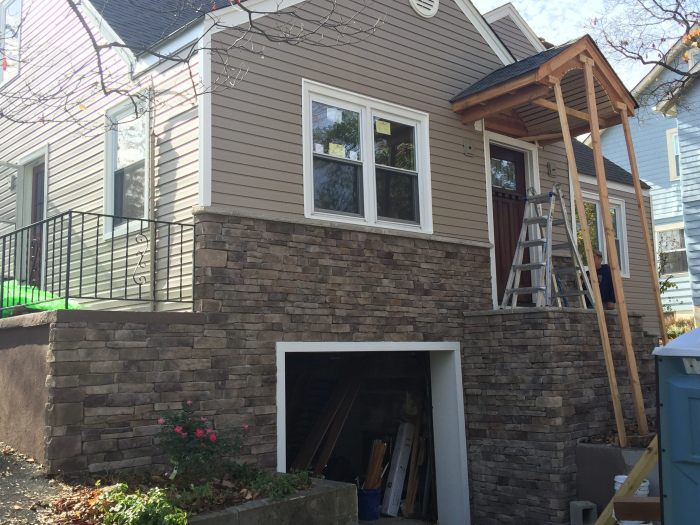
Choosing vinyl insulated siding involves a significant investment, and understanding the warranty offered by the manufacturer is crucial for protecting that investment. Warranties provide assurance against defects in materials and workmanship, offering peace of mind and recourse should problems arise. This section details typical warranty offerings, factors influencing warranty validity, the importance of reputable manufacturers and installers, and the claims process.
Standard warranties for vinyl insulated siding typically cover defects in materials and workmanship for a specified period. The length of the warranty can vary depending on the manufacturer and specific product line. Some manufacturers offer limited lifetime warranties, while others provide warranties for a specific number of years, such as 20 or 30 years. These warranties usually cover issues such as fading, cracking, and peeling, but may exclude damage caused by improper installation, natural disasters, or other external factors.
Warranty Comparison Across Manufacturers
Warranty terms can differ significantly between manufacturers. The following table provides a generalized comparison. Note that specific warranty details are subject to change and should be verified directly with the manufacturer. Always review the specific warranty document provided by the manufacturer for complete and accurate information.
| Manufacturer | Warranty Type | Coverage Duration | Key Exclusions |
|---|---|---|---|
| Manufacturer A | Limited Lifetime | Lifetime against fading and cracking | Improper installation, impact damage, acts of God |
| Manufacturer B | Limited Warranty | 20 years against defects | Improper installation, normal wear and tear, vandalism |
| Manufacturer C | Limited Warranty | 30 years against defects in materials | Acts of God, improper maintenance, discoloration from pollutants |
Factors Affecting Warranty Validity
Several factors can affect the validity of a vinyl insulated siding warranty. Understanding these factors is crucial to ensure your warranty remains in effect. Failure to adhere to these conditions may result in the warranty being voided.
- Proper Installation: Improper installation is a frequent reason for warranty denial. It’s essential to use qualified and experienced installers.
- Maintenance: Regular cleaning and maintenance, as recommended by the manufacturer, are typically required to maintain warranty coverage.
- Acts of God: Damage caused by natural disasters such as hurricanes, tornadoes, or hailstorms is usually excluded from most warranties.
- Vandalism or Abuse: Damage resulting from vandalism or intentional misuse of the siding will likely void the warranty.
- Compliance with Installation Instructions: Following the manufacturer’s installation instructions precisely is essential for warranty validity.
Importance of Reputable Manufacturers and Installers
Selecting a reputable manufacturer and installer is paramount to ensuring a long-lasting and trouble-free installation. Reputable manufacturers have a proven track record of producing high-quality products and standing behind their warranties. Similarly, experienced and qualified installers possess the necessary skills to install the siding correctly, minimizing the risk of defects and warranty issues.
Researching manufacturers and reading customer reviews can help identify those with a strong reputation for quality and customer service. Similarly, seeking referrals and checking licensing and insurance for installers are important steps to take before committing to a project.
Filing a Warranty Claim
The process of filing a warranty claim typically involves contacting the manufacturer directly. Most manufacturers provide detailed instructions on their websites or in the warranty documentation. Be prepared to provide documentation such as purchase receipts, installation records, and photographs of the damaged siding. The manufacturer will then assess the claim and determine whether the damage is covered under the warranty.
Promptly reporting any defects is important to expedite the claims process. The manufacturer may require an on-site inspection to assess the extent of the damage and determine the appropriate course of action, which might include repair or replacement of the affected siding.
FAQ Overview
What is the lifespan of vinyl insulated siding?
With proper installation and maintenance, vinyl insulated siding can last 30-50 years or more.
Can vinyl insulated siding be painted?
Generally, no. Vinyl siding is designed with its color embedded, and painting can void warranties.
How does vinyl insulated siding compare to fiber cement siding in terms of cost?
Fiber cement siding typically has a higher initial cost than vinyl insulated siding, but it may offer a longer lifespan.
Is professional installation necessary for vinyl insulated siding?
While DIY installation is possible, professional installation is recommended to ensure proper fitting, longevity, and warranty validity.
How often should I clean my vinyl insulated siding?
Annual cleaning with soap and water is generally sufficient. More frequent cleaning may be necessary in areas with heavy dirt or pollution.
